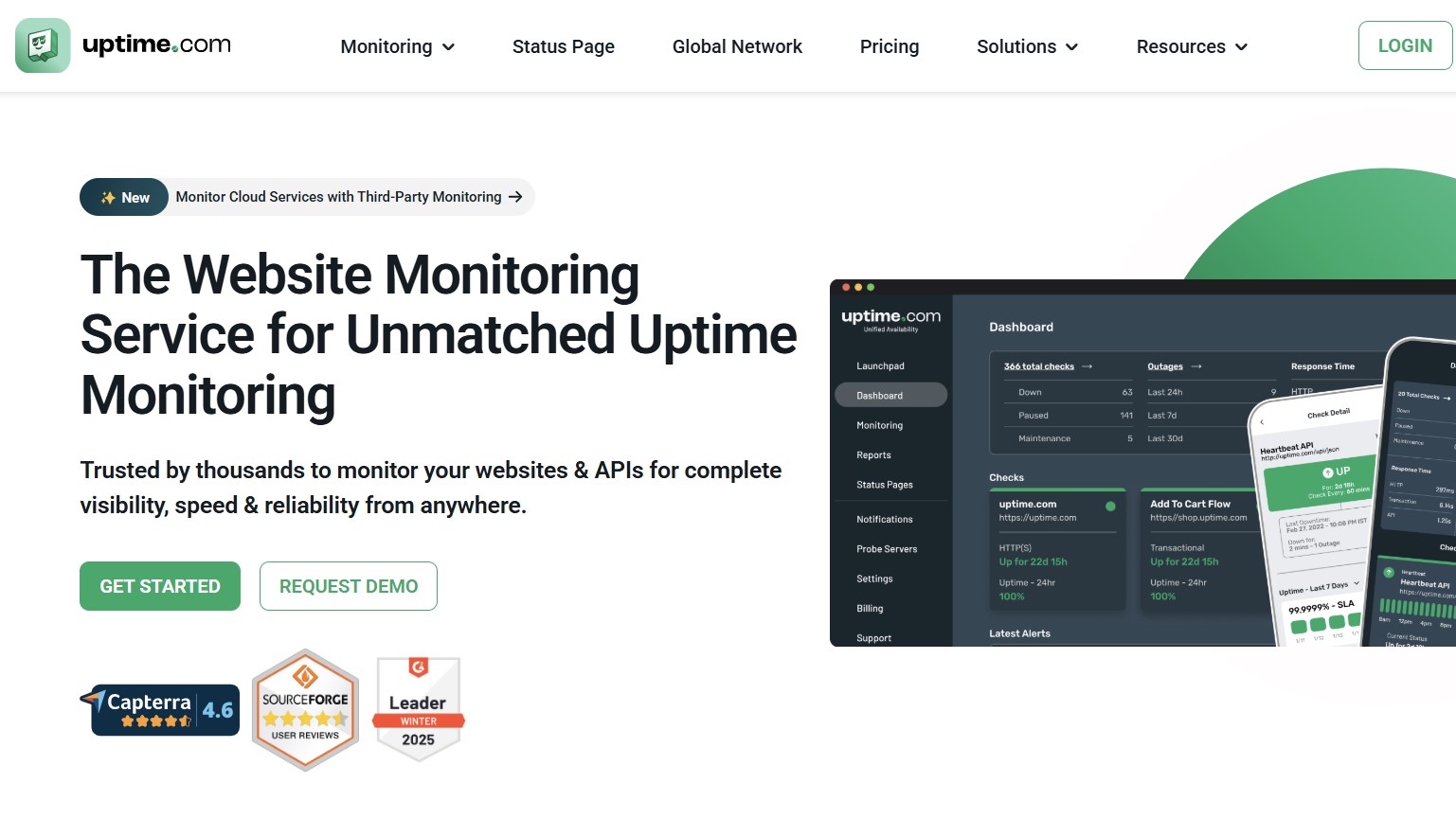Why you can trust TechRadar
We spend hours testing every product or service we review, so you can be sure you’re buying the best. Find out more about how we test.
Website monitoring is essential to ensure your web addresses stay functional at all times. Outages, if any, should be reported swiftly so that they can be tackled before bounce rates increase. Here’s where a robust tool like Uptime comes in handy.
Launched in 2013, Uptime.com caters to some big names, like Apple, Microsoft, and PwC. With 44.7M monitoring checks, 115K alerts, and 2,500+ status pages, Uptime has saved billions of dollars for companies around the world – all the while maintaining a 99.999% uptime.
Uptime offers 30 different check types, from basic HTTPS checks and advanced Real User Monitoring (RUM) to API endpoint and transaction checks. Hang around until the end as we explore one of the best website monitoring software in more detail, discussing its best features, pricing, and interface, and also listing down a couple of alternatives.
Uptime.com: Plans and pricing
Uptime offers four plans, meaning it caters to businesses of all sizes and needs. It all begins with the Starter plan priced at $20/month, which allows you to run 30 basic checks, 1 transaction, API, and page speed check each, along with 10 cloud status checks and 2 group checks.
The check frequency here is 5 minutes, and you get 4 check locations and 3 locations per check. You can also create 1 status page – private or public. This plan allows access to 50K RUM data points per month and data retention for up to 13 months. We found this plan offering good value for the money, making it ideal for startups with one site to manage.
Next comes the Essential plan at $67/month, where you get 50 basic checks, 5 transaction checks, and 10 API checks. The group check limit also increases to 10, and the check frequency drops to 3 minutes. The best part is that you can run checks for every location around the globe as well as enjoy 5 locations per check. The number of RUM data points also increases to 200K on this plan.
Unlike the Starter plan, you can customize the design of your status page here and also create password-protected status pages. The Essential plan is an extended version of the Starter one, ideal for small businesses.
If you’re a large business, you can switch to the Premium plan at $285/month, which pretty much has everything Uptime has to offer. This includes 200 basic checks, 15 transaction checks, and 20 API checks.
These checks can be run at an interval as low as 1 minute. You get 15 locations per check and the mighty ability to select private locations. More good news: SMS and phone alerts, both of which are capped in the previous two plans.
If even this subscription doesn’t fit your needs, you can build a plan from scratch with customizable configurations and billing.
Another good thing about Uptime is that it offers a 14-day free trial for all its paid plans – no credit card needed. So, you can take the service out for a spin before committing to a plan.
Uptime.com: Features
Uptime offers 3 free tools: domain health check, website page speed test, and global uptime test. The domain health test helps you check parameters like web and DNS performance, functionality, blacklist monitoring, and so on.
Speed tests help you determine loading speeds of your web page from various global locations, while the global uptime test checks a website’s responsiveness and provides insights into performance disparities.
Besides this, Uptime offers more than 30 check types. Basic checks such as HTTPS, Whois/Domain checks, TCP Port checks, and malware checks are available with every plan. Several advanced checks, such as API monitoring, transaction checks, group checks, and cloud checks, are also available.
For instance, the platform allows checking various APIs, such as REST APIs, gRPC APIs, and GraphQL APIs, to ensure they are working fine and alert the concerned team immediately in case there’s an issue.
Needless to say, you can also run Real User Monitoring (RUM), under which data from real users are analyzed to identify issues like 4xx and 5xx HTTP status codes and JavaScript issues, page load times, AJAX load times, and bounce rates.
This data-driven approach helps you fix minor issues before they become major business concerns. You can also access detailed RUM reports to drill down on user data.
Uptime also offers impressive no-code transaction checks that help you check specific website elements such as clicking a button, visiting a website, or entering information in a text field. You can even mimic entire user paths, such as adding items to a shopping cart or contact form submissions.
The platform’s synthetic transaction monitoring also supports advanced web applications such as MFA sites. For example, using Uptime, businesses can check whether 2FA on their site is functioning for all users.
Another feature we loved about Uptime was the Status pages, a powerful reporting and accountability tool that helps communicate outages and manage incidents more efficiently. Uptime offers 3 types of status pages: public, private, and SLA pages, each customizable with HTML and CSS.
Uptime.com: Interface and in use
The Uptime interface is clean and intuitive. You’ll see a panel on the left with all function options. Whenever you’re setting up a new check, you’ll see a window pop up with four options: Basic, Advanced, Escalations, and Maintenance.
For instance, if you want to run a basic HTTPS check, you’ll find it in the Basic tab. Similarly, advanced checks like RUM and transaction checks can be found in the Advanced tab.
Each check can be configured within seconds by simply filling out the required fields such as check type, contacts who’ll receive the notifications, locations to run the check from, and of course, the URL to be checked.
The Escalations tab makes it very easy to manage incidents by sending alerts to concerned team members. You can set up a hierarchy of escalations based on incident sensitivity.
You’ll see all the checks on the Uptime’s main dashboard along with a summary of all your checks. At just a glance, you can check variables like total checks, outages, response times, global uptime, and RUM load time. What we like the most is that the dashboard is fully customizable. So, you can start with a clean slate and only add data you want to see on the dashboard.
Overall, Uptime is easy to use and get the hang of. There are a lot of tutorials on the website with detailed step-by-step guides that help you set up and use the account. Sure, Uptime, like most website monitoring tools, does require a bit of getting used to. However, the learning curve isn’t steep, thanks to its huge knowledge base.
Uptime.com: Support
Uptime offers comprehensive support for both existing and potential customers. You can either fill out a contact form on the website, call them directly, or send them an email.
While direct contact with a support agent might be your only and last port of call, you can also check out the extensive library of free resources that’s more than capable of answering any questions you might have. There are detailed blogs, release notes, and API documentations, as well as a quick start guide – a lot of material to help you get the hang of the platform.
Last but not least, you’ll also get premium and priority support if you’re on the Premium plan.
Uptime.com: The competition
Uptime is undoubtedly a great website monitoring option for businesses. However, if for some reason it doesn’t suit your needs, you can consider UptimeRobot.
For starters, UptimeRobot offers a completely free plan with 50 monitors and 5 minutes of monitoring interval. You can run various checks such as HTTP, port & ping monitor, as well as benefit from a handy keyword monitor. UptimeRobot is also much cheaper than Uptime.com.
Even its most expensive plan costs just $54/month (for 200 monitors and 30-second intervals). However, UptimeRobot lacks Real User Monitoring, which is where Uptime.com really shines through.
Uptime.com: Final verdict
Uptime is a comprehensive website monitoring tool that lets you run more than 30 types of checks – both basic and advanced checks. You can evaluate the API status on your pages, micro and extended transaction checks, page speed tests, and real user monitoring statuses.
We liked the immediate response and alert mechanisms as well as the detailed escalation hierarchy that helps resolve issues at the earliest. You can get started with 3 free tools for domain health and speed checks and then upgrade to paid plans starting at $20/month.
The interface is pretty clean, and there’s a lot of knowledge material on the website to help you scale the slight learning curve. Plus, the support is robust with call, email, and contact form support.
Overall, Uptime delivers excellent value for money and is a good option for both small and large businesses.
FAQs
How is website monitoring different from content monitoring?
Website monitoring tools track the functionality of a given webpage. It checks whether the pages and its various components are working and reports if there are any unexpected page outages.
Content monitoring, on the other hand, tracks content changes on a webpage and reports whenever there are content updates. It comes in handy for businesses tracking competitors and for regulatory compliance.
Who is Uptime.com best for?
Uptime is a good value-for-money website monitoring tool ideal for both small and large businesses. Free tools like domain health checks and speed tests can help startups with basic monitoring.
Paid basic and advanced checks, starting at $20/month, help businesses draw in more insights from synthetic transactions and real user monitoring. Large businesses can opt for the $285/month Premium plan or build a custom plan from scratch.
We list the best website defacement monitoring service.
Read the full article here














